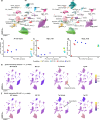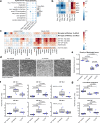Correction of dysregulated lipid metabolism normalizes gene expression in oligodendrocytes and prolongs lifespan in female poly-GA C9orf72 mice
- PMID: 40216746
- PMCID: PMC11992041
- DOI: 10.1038/s41467-025-58634-4
Correction of dysregulated lipid metabolism normalizes gene expression in oligodendrocytes and prolongs lifespan in female poly-GA C9orf72 mice
Abstract
Clinical and genetic research links altered cholesterol metabolism with ALS development and progression, yet pinpointing specific pathomechanisms remain challenging. We investigated how cholesterol dysmetabolism interacts with protein aggregation, demyelination, and neuronal loss in ALS. Bulk RNAseq transcriptomics showed decreased cholesterol biosynthesis and increased cholesterol export in ALS mouse models (GA-Nes, GA-Camk2a GA-CFP, rNLS8) and patient samples (spinal cord), suggesting an adaptive response to cholesterol overload. Consequently, we assessed the efficacy of the cholesterol-binding drug 2-hydroxypropyl-β-cyclodextrin (CD) in a fast-progressing C9orf72 ALS mouse model with extensive poly-GA expression and myelination deficits. CD treatment normalized cholesteryl ester levels, lowered neurofilament light chain levels, and prolonged lifespan in female but not male GA-Nes mice, without impacting poly-GA aggregates. Single nucleus transcriptomics indicated that CD primarily affected oligodendrocytes, significantly restored myelin gene expression, increased density of myelinated axons, inhibited the disease-associated oligodendrocyte response, and downregulated the lipid-associated genes Plin4 and ApoD. These results suggest that reducing excess free cholesterol in the CNS could be a viable ALS treatment strategy.
© 2025. The Author(s).
Conflict of interest statement
Competing interests: L.R.P., N.H., and D.O. are employees of Sanofi, but Sanofi is not actively developing CD-based therapeutics. The remaining authors declare no competing interests.
Figures






References
-
- Hardiman, O. et al. Amyotrophic lateral sclerosis. Nat. Rev. Dis. Prim.3, 17071 (2017). - PubMed
-
- Mackenzie, I. R. et al. Dipeptide repeat protein pathology in C9ORF72 mutation cases: clinico-pathological correlations. Acta Neuropathol.126, 859–879 (2013). - PubMed
-
- Neumann, M. et al. TDP-43-positive white matter pathology in frontotemporal lobar degeneration with ubiquitin-positive inclusions. J. Neuropathol. Exp. Neurol.66, 177–183 (2007). - PubMed
MeSH terms
Substances
Grants and funding
- 390857198/Deutsche Forschungsgemeinschaft (German Research Foundation)
- 407495230/Deutsche Forschungsgemeinschaft (German Research Foundation)
- 423957469/Deutsche Forschungsgemeinschaft (German Research Foundation)
- 390857198/Deutsche Forschungsgemeinschaft (German Research Foundation)
- 390857198/Deutsche Forschungsgemeinschaft (German Research Foundation)
LinkOut - more resources
Full Text Sources
Medical
Molecular Biology Databases
Research Materials
Miscellaneous

